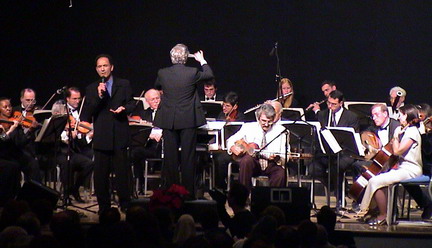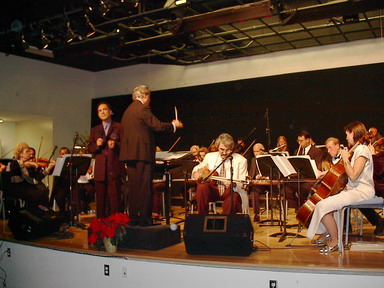Program
Notes | Photos
MESTO
Multi-Ethnic Star Orchestra Presents
A Special Thanksgiving Concert
Sunday, 25 November 2001 at West Los Angeles
College
Sama'i
Farahfaza. By Tamburi
Cemil Bey, arranged by Nabil Azzam
The Sama'i form has four khanat sections and a taslim (refrain)
played after each khana. The last khana is played in fast
tempo of either 3/4 or 6/8. Those who are familiar with
Sama'i Farafaza will notice the new melodies inserted into
the original composition-the opening section led by the
oboe and other woodwinds and the dialogue between solo instruments
and the orchestra that is typical to the form of Tahmila,
where a solo instrument leads in improvising melodies that
are repeated by the takht ensemble.
Longa
"Sultani Yegah."
By Tamburi Cemil Bey, arranged by Nabil Azzam
This very well-known Longa is performed by 'ud and qanun players
as a showcase composition. There is little evidence that the
opening section of this piece was composed by Cemil Bey. Thematically
the first section fits the general style of an introduction,
usually in slow tempo. The longa is easily recognized by its
lively duple meter.
Avraham
Avinu (Abraham, Our Patriarch). Variations on a Sephardic
melody composed by Nabil
Azzam. Arranged by Kareem Roustom
This basic melody is widely heard among the Sephardic communities
in Spain and the Balkan area. The text is written in Ladino
(a language mix of Spanish and Hebrew). Azzam added two distinctive
variations to the original song melodies. In this arrangement
Roustom assigns the main melody to the clarinet.
Romanian
Suite. By Miamon Miller
Romania has many different types of regional folk music. This
three-part suite reflects that diversity. The first two sections
were composed in the style of village folk music from the
regions of Bihor and Banat. The third piece is a sort of composed
arrangement based on a pre-existing melody. Historically it
belongs in the category of salon music, much in the same vein
as the "Hora Staccato" made famous by the virtuoso
violinist Jascha Heifetz.
Alf
Layla (One Thousand One Nights).
By Baligh Hamdi. Arranged by Joseph Chamaa and Nabil
Azzam
This is the instrumental introduction to a song of Umm Kulthum.
Many composers have written long introductions for their songs
as a marketing tool for their instrumental music. These pieces
are often performed as independent instrumental compositions
without the song itself. Joseph Chamaa successfully chose
this composition to be arranged for Mesto.
Bahlam
Biek (I Dream of You).
Music by Kamal al-Tawil
Nabil Azzam, solo violin
The original melody was performed by the famous Egyptian singer
Abdel Halim Hafez in the 1960s. Bahlam Biek was a hit and
widely known throughout the Middle East. It is not unusual
to record famous songs by a solo instrument replacing the
vocal line. Many great instrumentalists have released their
renditions of popular songs. This song has an opening theme
and four different sections. The orchestra plays short fillers
as well as the repeated melody (refrain).
I
N T E R M I S S I O N
Tango
"La Cumparsita".
By M. Rodreguez; Arranged by Betty Byers
Very
few melodies have won wide popularity and recognition. La
Cumparsita is certainly on of these "lucky" tunes.
It is accepted in many cultures from the Middle East to the
Far East and even lyrics were composed to the original melody.
Previously, Betty Byers arranged this tune for string
quartet and now she has successfully rearranged it for MESTO
taking into consideration the kind of instruments used in
the orchestra.
Miserlou.
Arranged by Shelly Cohen
When the popular song Miserlou was first introduced to the
Western audience, it was thought to be of Greek origin. That
presumption was recently contested in contradictory ways.
New studies by musicologists have argued that the origins
of this haunting melody may lie not with the Greeks but possibly
with age-old Hasidic music. Others go further to attribute
Miserlou to Druze origins of Southern Lebanon! In any form
though, Miserlou still rings pleasantly in our ears.
Sephardic
Medley. Arranged by
Shelly Cohen
The music of the Sephardim is an amalgam of two distinct cultures:
the Jewish and the Moorish. In Spain Jewish composers borrowed
from each other to create a new entity. Spanish/Moorish rhythms
and Jewish melodies were combined to give to the world a delightful
and refreshingly new musical sound. Picture in your mind's
eye this unique joining of cultures, then listen and enjoy.
Fatit
Ganbina: Lyrics by Husayn
al-Sayyid; Music by M. 'Abd al-Wahhab. Arranged by
Nabil Azzam
A
Unique Performance by
Hamid
The lyrics tell the story of two young men who were interested
in one pretty girl who does not make her inclination clear
to either one of them, thus causing confusion and uncertain
love.
Two
Persian Songs With Guest Singer
Ahmad Ahmadi
Ilahi Naz.
Lyrics by Akbar Muhsini;
Music by Ruhullah Khaliqi. Arranged by Nabil Azzam
Hallaj
Vashan. Lyrics by Mulana Rumi;
Music by Kamil Alipour. Arranged by Nabil Azzam
Conductor Nabil Azzam would like to thank Mr. Jamie Papish
and Melanie for printing this program.
Guest Singer Ahmad Ahmadi performs Persian
songs
Also Mr. Kamil Alipour, master composer
and tar player



Star
singer Hamid




|